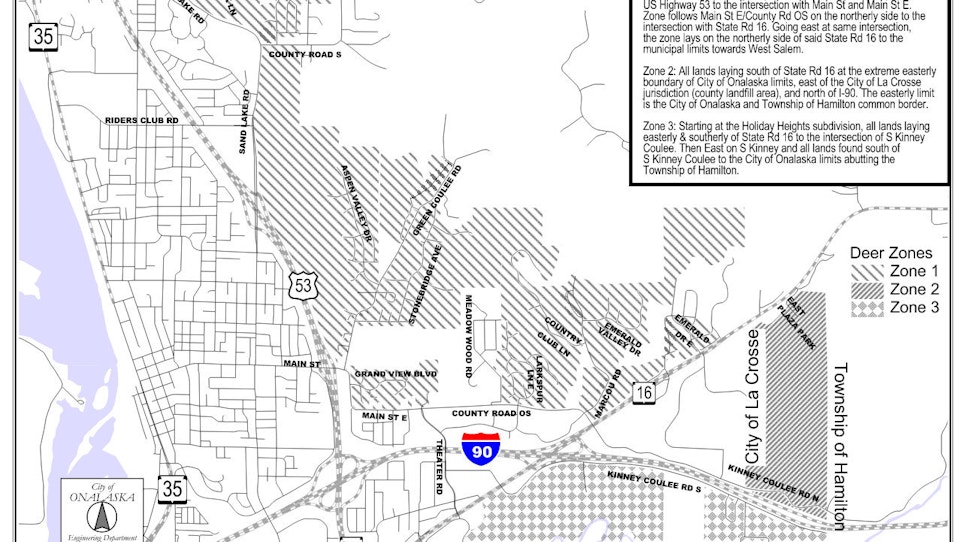When I moved to Missouri, I had no access to private land, nor was I prepared to pay $20 or more per acre for a lease. So, I was left with state and federal land as my only options…or so I thought. I quickly learned that several city-owned areas were part of a bowhunting program in order to reduce deer densities and, in turn, the number of deer vs. vehicle collisions.
I attended a short class held by the city and state officials outlining the rules and regulations, properties and boundaries, and reporting system. With the completion of the class I received a permit allowing me to hunt any of the designated areas throughout the season with my bow. There were at least 75 people in my class, so to say I was hesitant to expect success when most of the enrolled properties were less than 200 acres was an understatement. But after the first week of the season, it was like I had the entire property I was focused on to myself.
I had used aerial photos and topographical maps to determine a few areas I thought were “hot spots” and planned to hunt and scout throughout the early season. I have to admit, I wasn’t sure what my cameras would yield in terms of “nice” bucks on public land, but to my surprise I had a number of digital buck images, including some that showed a mature 130-inch brute. I had to chuckle that I was building a “hit list” for public land versus taking one of the first decent and legal bucks I saw.
The second week of the season I slipped back toward the border of the property (I hike with a 20-pound climbing stand on my back). It was a rainy, warm afternoon, so my expectations were fairly low. About two hours before dark I caught movement coming from a thick cedar stand in front of me. My jaw hit the ground as the mature buck I’d captured on camera came on a march toward my tree. When he got to where I could see him through the platform of my stand, I could barely breathe. Then, out of nowhere, the classic snort and bolt. What happened? What went wrong? He had come across the spot next to the tree where I set my gear down to get situated. I never saw that deer again.
Now if the story ended there, it may be enough for some of you to get motivated and hunt city ground. But it doesn’t. Believe it or not, it actually got better.
The exact same night the mature buck left my heart racing, a camera 200 yards away captured video of the largest buck I would see all year. This monster (estimated 150-inch 11-point) was a ghost to me all season, only showing up once or twice a month and, other than that first sighting, always in the middle of night.
In late October a third mature buck showed up. He was likely a 4½-year-old and would stretch the tape to about 125 inches as an 8-point. A great deer for anywhere, let alone public land. He too was very nocturnal, but all the bigger bucks were during the dreaded “fall lull.” But as the rut got closer, so did his movement with regards to shooting hours.
On November 1, a very warm and windy day, I harvested my first deer on city ground. It was a mature doe that easily weighed over 140 pounds. After dragging the doe out and heading for home, the 125-inch 8-point that showed up in late October crossed the road right in front of me. He was about three quarters of a mile as the crow flies from my nearest stand, which was nestled near the property border. Three days later on November 4 after a relatively uneventful morning hunt, I climbed down and began the walk toward my truck. To my surprise, in the exact same spot I’d seen him three days earlier, the big 8-point came blowing across the road chasing a doe.
On November 5 I headed to the closest stand I had to where I had seen the buck. Before shooting light I had a deer come by at a fast trot followed by not one, not two, but three bucks grunting hard. I later discovered I’d captured one, a nice 2 ½-year-old, on camera. The moment shooting light broke, I rattled lightly, calling in a small 3-point. About a half hour later I rattled again, and this time called in two bucks from behind me. One was a really nice 8-point that I had never seen before. About 30 minutes later I clacked the horns again, and two decent 6-point bucks and the same nice 8-point came in. Though I didn’t have a shot at the 8-point, this was quickly turning into one of my best bowhunts. (Note: This particular tract of land had a solid buck-to-doe ratio, which I’d discovered during my scouting.)
At 9 a.m. I let out a super-intense rattling sequence and to my astonishment my target buck – yep, the big 8-point I’d seen twice – came on a string. I deflated his lungs with a perfect arrow. The tracking job was short. The memories of that bowhunt and the sight of that 127-inch public-land brute lying on the ground will be forever etched into my memory.
To this day I continue to bowhunt public land. The amount of time and work that goes into harvesting a deer with a bow on these “open” lands is exhilarating. That particular property was hit hard by EHD (Epizootic Hemorrhagic Disease) the following year, and unfortunately hasn’t been the same since, but there are many just like it spread across the country. Be sure to get online and check your local municipalities and cities for opportunities to bag a big buck on city-owned ground. You won’t be disappointed.






